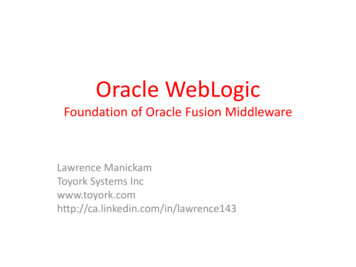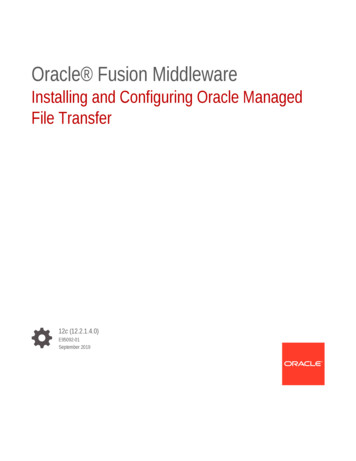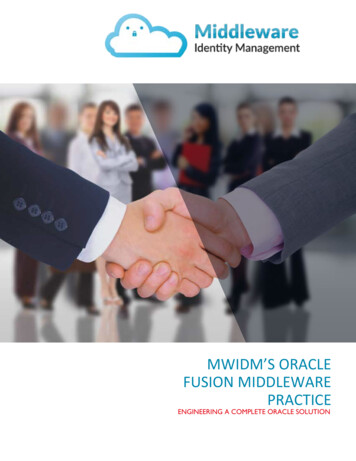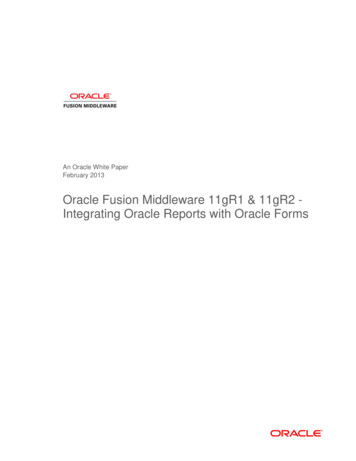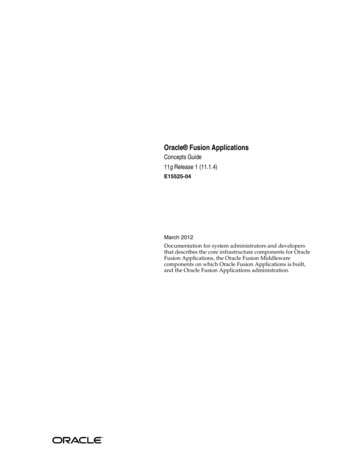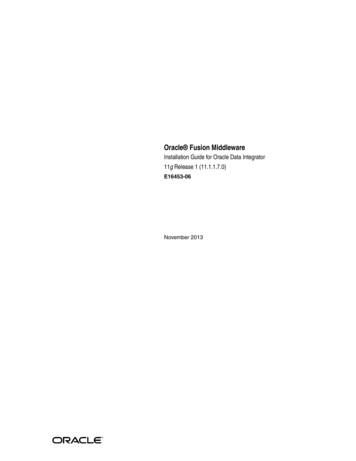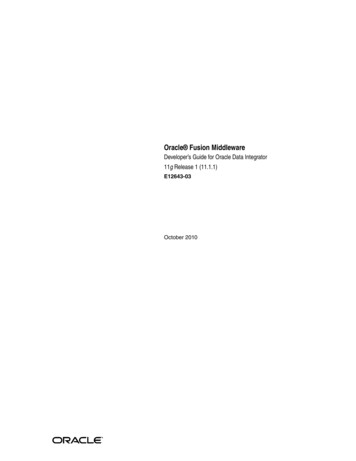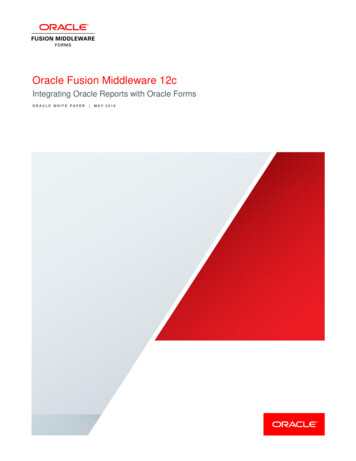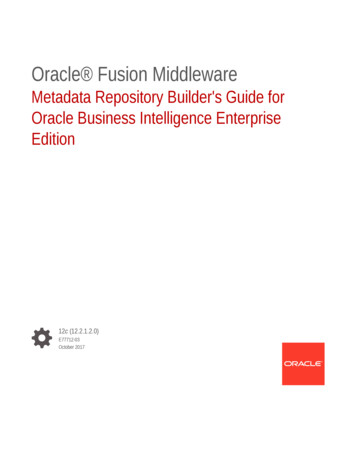
Transcription
Oracle Fusion MiddlewareMetadata Repository Builder's Guide forOracle Business Intelligence EnterpriseEdition12c (12.2.1.2.0)E77712-03October 2017
Oracle Fusion Middleware Metadata Repository Builder's Guide for Oracle Business Intelligence EnterpriseEdition, 12c (12.2.1.2.0)E77712-03Copyright 2017, Oracle and/or its affiliates. All rights reserved.Primary Author: Helen GilmoreContributors: Oracle Business Intelligence development, product management, and quality assurance teamThis software and related documentation are provided under a license agreement containing restrictions onuse and disclosure and are protected by intellectual property laws. Except as expressly permitted in yourlicense agreement or allowed by law, you may not use, copy, reproduce, translate, broadcast, modify,license, transmit, distribute, exhibit, perform, publish, or display any part, in any form, or by any means.Reverse engineering, disassembly, or decompilation of this software, unless required by law forinteroperability, is prohibited.The information contained herein is subject to change without notice and is not warranted to be error-free. Ifyou find any errors, please report them to us in writing.If this is software or related documentation that is delivered to the U.S. Government or anyone licensing it onbehalf of the U.S. Government, then the following notice is applicable:U.S. GOVERNMENT END USERS: Oracle programs, including any operating system, integrated software,any programs installed on the hardware, and/or documentation, delivered to U.S. Government end users are"commercial computer software" pursuant to the applicable Federal Acquisition Regulation and agencyspecific supplemental regulations. As such, use, duplication, disclosure, modification, and adaptation of theprograms, including any operating system, integrated software, any programs installed on the hardware,and/or documentation, shall be subject to license terms and license restrictions applicable to the programs.No other rights are granted to the U.S. Government.This software or hardware is developed for general use in a variety of information management applications.It is not developed or intended for use in any inherently dangerous applications, including applications thatmay create a risk of personal injury. If you use this software or hardware in dangerous applications, then youshall be responsible to take all appropriate fail-safe, backup, redundancy, and other measures to ensure itssafe use. Oracle Corporation and its affiliates disclaim any liability for any damages caused by use of thissoftware or hardware in dangerous applications.Oracle and Java are registered trademarks of Oracle and/or its affiliates. Other names may be trademarks oftheir respective owners.Intel and Intel Xeon are trademarks or registered trademarks of Intel Corporation. All SPARC trademarks areused under license and are trademarks or registered trademarks of SPARC International, Inc. AMD, Opteron,the AMD logo, and the AMD Opteron logo are trademarks or registered trademarks of Advanced MicroDevices. UNIX is a registered trademark of The Open Group.This software or hardware and documentation may provide access to or information about content, products,and services from third parties. Oracle Corporation and its affiliates are not responsible for and expresslydisclaim all warranties of any kind with respect to third-party content, products, and services unless otherwiseset forth in an applicable agreement between you and Oracle. Oracle Corporation and its affiliates will not beresponsible for any loss, costs, or damages incurred due to your access to or use of third-party content,products, or services, except as set forth in an applicable agreement between you and Oracle.
ContentsPrefaceAudiencexxiiiDocumentation AccessibilityxxiiiRelated Documentation and Other ResourcesxxiiiConventionsxxivNew Features for Oracle BI Metadata Repository Builders1New Features for Oracle BI EE 12c (12.2.1.1.0)xxvNew Features for Oracle BI EE 12c Release (12.2.1.0)xxvIntroduction to Building Your Metadata RepositoryAbout Oracle BI Server Architecture1-1About Layers in the Oracle BI Repository1-2Analyzing Your Business Model Requirements1-4Identifying the Content of the Business Model1-5Identifying Logical Fact Tables1-5Identifying Logical Dimension Tables1-6Identifying Dimensions1-7About Dimensions with Multiple HierarchiesIdentifying Lookup TablesIdentifying the Data Source Content for the Physical Layer1-81-91-9About Types of Physical Schemas in Relational Data Sources1-10About Cubes in Multidimensional Data Sources1-11Identifying the Data Source Table Structure1-11Guidelines for Designing a Repository1-12Design Strategies for Structuring the Repository1-12Design Tips for the Physical Layer1-12Design Tips for the Business Model and Mapping Layer1-13Modeling Outer JoinsDesign Tips for the Presentation LayerTopics of Interest in Other Guides1-151-151-16iii
System Requirements and Certification2Before You BeginAbout the Oracle BI Administration Tool2-1Opening the Administration Tool2-1Setting Administration Tool Options2-2Oracle BI Administration Tool General Options2-2Oracle BI Administration Tool Repository Options2-5Editing, Deleting, and Reordering Objects in the Repository2-6About Naming Requirements for Repository Objects2-6Changing Icons for Repository Objects2-7Sorting Objects in the Administration Tool2-7About the Oracle BI Server Command-Line Utilities2-8About Options in NQSConfig.INI2-10About the SampleApp.rpd Demonstration Repository2-10Download Repository Command2-11What You Need to Know Before Using the Command2-12Using Online and Offline Repository Modes2-13Editing Repositories in Offline Mode2-14Opening Repositories in Offline Mode2-14Publish Offline Changes2-14Editing Repositories in Online Mode2-15Opening Repositories in Online Mode2-15Publishing Online Changes2-16Guidelines for Using Online Mode2-17Checking Out Objects2-18Checking In Changes2-18About Read-Only Mode2-18Checking the Consistency of a Repository or a Business Model31-172-19About the Consistency Check Manager2-19Running the Consistency Check Manager2-21Using the validaterpd Utility to Check Repository Consistency2-22Common Consistency Check Messages2-23Setting Up and Using the Multiuser Development EnvironmentAbout the Multiuser Development Environment3-1About the Multiuser Development Process3-2Setting Up Projects3-3About Projects3-4iv
Creating Projects3-4About Converting Older Projects During Repository Upgrade3-5Setting Up the Multiuser Development DirectoryIdentifying the Multiuser Development Directory3-6Copying the Master Repository to the Multiuser Development Directory3-7Setting Up a Pointer to the Multiuser Development Directory3-7Making Changes in a Multiuser Development Environment3-8About Changing and Testing Metadata3-8Making Changes to a Repository Using Projects3-9About Repository Project Checkout3-9Checking Out Projects3-10Using the extractprojects Utility3-11Refreshing the Local Project Extract3-12Making Changes to an Entire Repository3-12About Multiuser Development Options3-12Publishing Changes to Multiuser Development RepositoriesAbout the Multiuser Development Merge ProcessHow Are Multiuser Merges Different from Standard Repository Merges?3-133-143-15Publishing to the Network3-15Enforcing Consistent Repositories When Publishing Changes3-16Branching in Multiuser Development3-16About Branching3-17Using the Multi-Team, Multi-Release Model in Oracle Business Intelligence3-19Synchronizing RPD Branches3-19Viewing and Deleting History for Multiuser Development3-19Viewing Multiuser Development History3-20Deleting Multiuser Development History3-20Setting Multiuser Development Options43-63-21Using a Source Control Management System for RepositoryDevelopmentAbout Using a Source Control Management System with the Administration ToolAbout MDS XMLSetting Up Your System for Repository Development Under Source ControlManagement4-14-24-4Creating an SCM Configuration File4-4Creating an MDS XML Repository and Checking In Files to the SCM System4-6Saving an Existing Repository File in MDS XML Format4-6Creating a New Repository in MDS XML Format4-7Linking to Source Control Files to Convert Your Repository (SmallRepositories Only)4-7v
Using Source Control Management in Day to Day Repository DevelopmentUpdating, Saving, and Checking In Changes for Repositories Under SourceControl4-8Handling Errors4-9Testing Repositories Under Source Control4-10Viewing the Source Control Log4-10Using Source Control Management with MUD54-84-11Putting the MUD Master Repository and MUD Log File Under Source Control4-11Checking In New Versions of the MUD Master and MUD Log File to SourceControl4-12Manually Checking In the Updated MUD Master Repository and Log File4-12Using a Script to Check In the Updated MUD Master Repository and LogFile4-12Importing Metadata and Working with Data SourcesAbout Importing Metadata and Working with Data Sources5-1Creating an Oracle BI Repository5-2Performing Data Source Preconfiguration Tasks5-2Setting Up ODBC Data Source Names (DSNs)5-3Setting Up Oracle Database Data Sources5-4Oracle 12c Database In-Memory Data Sources5-4Oracle 12c on Exadata Data Sources5-4Advanced Oracle Database Features Supported by Oracle BI Server5-5Oracle Database Fast Application Notification and Fast Connection Failover5-5Additional Oracle Database Configuration for Client Installations5-6Configuring Oracle BI Server When Using a Firewall5-6DataDirect Drivers and Oracle Database5-6Oracle Database Connection Errors in Windows 7 64-bit Environments5-7About Setting Up Oracle OLAP Data Sources5-7Java Data Sources5-7Loading Java Data SourcesAbout Setting Up Oracle TimesTen In-Memory Database Data Sources5-85-8Configuring TimesTen Data Sources5-9Improving Use of System Memory Resources with TimesTen Data Sources5-9Configuring OBIS to Access the TimesTen DLL on Windows5-10About Setting Up Essbase Data Sources5-11About Setting up Cloudera Impala Data Sources5-11Obtaining Windows ODBC Driver for Client Installation5-11Importing Cloudera Impala Metadata Using the Windows ODBC Driver5-11About Setting Up Apache Hive Data SourcesObtaining Windows ODBC Driver for Client Installation5-125-12vi
Limitations on the Use of Apache Hive with Oracle Business IntelligenceAbout Setting Up Hyperion Financial Management Data SourcesPerforming Additional Hyperion Configuration for Client Installations5-155-17Setting Up SAP/BW Data Sources5-18Setting Up Oracle RPAS Data Sources5-18Setting Up Teradata Data Sources5-18Avoiding Spool Space Errors for Queries Against Teradata Data Sources5-19Enabling NUMERIC Data Type Support for Oracle Database and TimesTen5-20Configuring Essbase to Use a Shared Logon5-21Configuring SSO for Essbase, Hyperion Financial Management, or HyperionPlanning Data Sources5-21Importing Metadata from Relational Data Sources5-21Importing Metadata from Multidimensional Data Sources5-24Multidimensional Data Source Connection Options5-25About Importing Metadata from Oracle RPAS Data Sources5-27About Importing Metadata from XML Data Sources5-28About Using XML as a Data Source5-29Importing Metadata from XML Data Sources Using the XML Gateway5-30Examples of XML Documents Generated by the Oracle BI Server XMLGateway5-32About Using HTML Tables as a Data Source5-37Importing Metadata from XML Data Sources Using XML ODBCExample of an XML ODBC Data SourceExamples of XML DocumentsAbout Using a Standby Database with Oracle Business Intelligence65-135-385-395-405-43Configuring a Standby Database with Oracle Business Intelligence5-43Creating the Database Object for the Standby Database Configuration5-44Creating Connection Pools for the Standby Database Configuration5-45Updating Write-Back Scripts in a Standby Database Configuration5-45Setting Up Usage Tracking in a Standby Database Configuration5-46Setting Up Event Polling in a Standby Database Configuration5-46Setting Up Oracle BI Scheduler in a Standby Database Configuration5-46Working with ADF Data SourcesWhat Are ADF Business Components?About Operational Reporting with ADF Business Components6-16-2About Importing ADF Business Components Into Oracle Business Intelligence6-2About Specifying a SQL Bypass Database6-3Setting Up ADF Data Sources6-4Creating a WebLogic Domain for ADF Business Components Used with OracleBusiness Intelligence6-4vii
Deploying OBIEEBroker as a Shared Library in Oracle WebLogic Server6-5Deploying the Application EAR File to Oracle WebLogic Server from JDeveloper6-6Setting Up a JDBC Data Source in the WebLogic ServerSetting the Logging Level for the Deployed Application in Oracle WebLogicServerImporting Metadata from ADF Data Sources6-106-10Performing an Initial Import from ADF Data Sources6-10Using Incremental Import to Propagate Flex Object Changes6-12Automatically Mapping Flex Object Changes to the Logical Model6-13Customizing the Mapping Behavior6-14Manually Mapping Flex Object Changes to the Logical Model6-14Automatically Mapping Flex Object Changes Using the biserverextender UtilityConfiguring SSL in Oracle WebLogic Server76-96-156-16Configuring One-Way SSL in Oracle WebLogic Server6-16Configuring Two-Way SSL in Oracle WebLogic Server6-16Enabling the Ability to Pass Custom Parameters to the ADF Application6-18Propagating Labels and Tooltips from ADF Data Sources6-19What are Labels and Tooltips?6-19About the Session Variable Naming Scheme for UI Hints6-20About Determining the Physical Column for a Presentation Column6-21About Initializing Session Variables Automatically for Propagating UI Hints6-21Using UI Hints From an Oracle ADF Data Source When Creating Analyses6-22Using XML Code in Initialization Blocks to Query UI Hints6-23Setting Up Database Objects and Connection PoolsSetting Up Database Objects7-1About Database Types in the Physical Layer7-1Creating a Database Object Manually in the Physical Layer7-2When to Allow Direct Database Requests by Default7-3SQL Features Supported by a Data Source7-4Viewing Database Properties7-6Reviewing Supported Database Features7-7About Connection PoolsAbout Connection Pools for Initialization BlocksCreating or Changing Connection PoolsSetting Connection Pool Properties in the General TabCommon Connection Pool Properties in the General TabMultidimensional Connection Pool Properties in the General Tab7-77-87-97-97-97-13Setting Connection Pool Properties in the Connection Scripts Tab7-15Setting Connection Pool Properties in the XML Tab7-16viii
Setting Connection Pool Properties in the Write Back Tab7-17Connection Pool Properties in the Miscellaneous Tab7-18Specifying Application Properties for JDBC (Direct Driver) or JDBC (JNDI)Data SourcesEXECUTE PHYSICAL DATABASESetting Up Persist Connection Pools87-197-207-20Removing the Persist Connection Pool Property7-21About Setting the Buffer Size and Transaction Boundary7-21List Connection Pool Command7-21Update Connection Pool Command7-23Using the BIServerT2PProvisioner.jar Utility to Change Connection Pool Passwords7-24Working with Physical Tables, Cubes, and JoinsAbout Working with the Physical Layer8-1Working with the Physical Diagram8-2Creating Physical Layer Folders8-4Creating Physical Layer Catalogs and Schemas8-4Creating Catalogs8-4Creating Schemas8-5Using a Variable to Specify the Name of a Catalog or Schema8-5Setting Up Display Folders in the Physical Layer8-6Working with Physical Tables8-6About Tables in the Physical Layer8-7About Physical Alias Tables8-9Creating and Managing Physical Tables and Physical Cube Tables8-11Creating or Editing Physical Tables8-11Creating Alias Tables8-13Setting Physical Table Properties for XML Data Sources8-13Creating and Managing Columns and Keys for Relational and Cube Tables8-13Creating and Editing a Column in a Physical Table8-14Specifying a Primary Key for a Physical Table8-15Deleting Physical Columns for All Data Sources8-15Viewing Physical Column Properties8-16Viewing Data in Physical Tables or Columns8-16Working with Multidimensional Sources in the Physical Layer8-16About Physical Cube Tables8-16About Measures in Multidimensional Data Sources8-17About Externally Aggregated MeasuresAbout Working with Physical Dimensions and Physical Hierarchies8-178-18Working with Physical Dimension Objects8-18Working with Physical Hierarchy Objects8-19ix
Working with Cube Variables for SAP/BW Data Sources8-21Viewing Members in Physical Cube Tables8-22Working with Essbase Data SourcesAbout Using Essbase Data Sources with Oracle BIAbout Incremental ImportWorking with Essbase Alias Tables8-228-238-258-26Determining the Value to Use for Display8-26Explicitly Defining Columns for Each Alias8-26Modeling User-Defined Attributes8-27Associating Member Attributes to Dimensions and Levels8-27Modeling Alternate Hierarchies8-28Modeling Measure Hierarchies8-29Improving Performance by Using Unqualified Member Names8-29Working with Hyperion Financial Management and Hyperion Planning Data Sources8-30Importing Metadata From Hyperion Financial Management Data Sources8-30Importing Metadata From Hyperion Planning Data Sources8-32About Query Support for Hyperion Financial Management and HyperionPlanning Data Sources8-34Working with Oracle OLAP Data Sources8-34About Importing Metadata from Oracle OLAP Data Sources8-35Working with Oracle OLAP Analytic Workspace (AW) Objects8-35Working with Oracle OLAP Dimensions, Hierarchies, and Levels8-36Working with Oracle OLAP Cubes and Columns8-37Working with Physical Foreign Keys and JoinsAbout Physical Joins8-388-38About Primary Key and Foreign Key Relationships8-39About Complex Joins8-39About Multi‐Database Joins8-39About Fragmented Data8-40Defining Physical Joins with the Physical Diagram8-41Defining Physical Joins with the Joins Manager8-42Deploying Opaque Views8-42About Deploying Opaque Views8-43Deploying Opaque View Objects8-43Using the Create View SELECT Statement8-43Undeploying a Deployed View8-45When to Delete Opaque Views or Deployed Views8-46When to Redeploy Opaque Views8-46Using Hints in SQL Statements8-46How to Use Oracle Hints8-47About the Index Hint8-47x
About the Leading HintAbout Performance Considerations for Hints8-47Creating Hints8-48Displaying and Updating Row Counts for Physical Tables and ColumnsDisplaying Row Counts in the Physical Layer98-478-488-49Working with Logical Tables, Joins, and ColumnsAbout Working with the Business Model and Mapping Layer9-1Creating the Business Model and Mapping Layer9-2Creating Business Models9-2Automatically Creating Business Model Objects9-3Automatically Creating Business Model Objects for Multidimensional DataSources9-3Duplicating a Business Model and Subject Area9-3About Working with the Business Model Diagram9-4Creating and Managing Logical Tables9-5Creating Logical TablesEnabling Data Driven Fragment Selection in Logical Table Sources9-69-7Specifying a Primary Key in a Logical Table9-7Reviewing Foreign Keys for a Logical Table9-7Defining Logical JoinsDefining Logical Joins with the Business Model DiagramDefining Logical Joins with the Joins Manager9-89-99-10Creating Logical Joins with the Joins Manager9-10Creating Logical Foreign Key Joins with the Joins Manager9-11Specifying a Driving Table9-12Factors That Determine Join Trimming9-13Identifying Physical Tables That Map to Logical Objects9-16Creating and Managing Logical Columns9-16Creating Logical Columns9-17Basing the Sort for a Logical Column on a Different Column9-17Enabling Double Column Support by Assigning a Descriptor ID Column9-18Creating Derived Columns9-18Configuring Logical Columns for Multicurrency SupportSetting Default Levels of Aggregation for Measure Columns9-199-20Setting Up Dimension-Specific Aggregate Rules for Logical Columns9-22Specifying Dimension-Specific Aggregation Rules for Multiple LogicalColumns9-22Defining Aggregation Rules for Multidimensional Data Sources9-23Associating an Attribute with a Logical Level in Dimension Tables9-25Moving or Copying Logical Columns9-25xi
Enabling Write Back On Columns9-26Setting Up Display Folders in the Business Model and Mapping Layer9-28Modeling Bridge Tables9-29Creating Joins in the Physical Layer for Bridge and Associated DimensionTables9-30Modeling the Associated Dimension Tables in a Single Dimension9-30Modeling the Associated Dimension Tables in Separate Dimensions9-32Modeling Binary Large Object (BLOB) Data and Character Large Object (CLOB)Data109-33Working with Logical DimensionsAbout Working with Logical Dimensions10-1Creating and Managing Dimensions with Level-Based Hierarchies10-2About Level-Based HierarchiesAbout Using Dimension Hierarchy Levels in Level-Based HierarchiesManually Creating Dimensions, Levels, and Keys with Level-Based Hierarchies10-210-510-6Creating Dimensions in Level-Based Hierarchies10-6Creating Logical Levels in a Dimension10-7Associating a Logical Column and Its Table with a Dimension Level10-8Identifying the Primary Key for a Dimension Level10-11Selecting and Sorting Chronological Keys in a Time Dimension10-12Adding a Dimension Level to the Preferred Drill Path10-12Adding Sequence Numbers to a Time Dimension's Logical Level10-13Rules for Automatically Created Dimensions with Level-Based Hierarchies10-13Automatically Creating Dimensions with Level-Based Hierarchies10-15Populating Logical Level Counts Automatically10-15Creating and Managing Dimensions with Parent-Child HierarchiesAbout Parent-Child Hierarchies10-1610-16About Levels and Distances in Parent-Child Hierarchies10-17About Parent-Child Relationship Tables10-18Creating Dimensions with Parent-Child Hierarchies10-20Defining Parent-Child Relationship Tables10-20Modeling Aggregates for Parent-Child Hierarchies10-21Storing Facts for Parent-Child Hierarchies10-22Aggregating Parent-Child Hierarchies10-23Adding the Parent-Child Relationship Table to the Model10-25Maintaining Parent-Child Hierarchies Based on Relational Tables10-26Modeling Time Series Data10-26About Time Series Functions10-26About the AGO Function10-27About the TODATE Function10-28xii
About the PERIODROLLING FunctionCreating Logical Time Dimensions10-31Setting Chronological Keys for Each Level10-3210-32Managing Logical Table Sources (Mappings)About Logical Table Sources11-1How Fact Logical Table Sources Are Selected to Answer a Query11-1How Dimension Logical Table Sources Are Selected to Answer a Query11-2Changing the Default Selection Criteria for Dimension Logical TableSources11-2Consistency Among Data in Multiple Sources11-3Creating Logical Table Sources11-3Setting Priority Group Numbers for Logical Table Sources11-4Defining Physical to Logical Table Source Mappings and Creating Calculated Items11-7Unmapping a Logical Column from Its SourceDefining Content of Logical Table Sources11-911-9Verifying Joins from Dimension Tables to Fact Tables11-10About WHERE Clause Filters11-12About Working with Parent-Child Settings in the Logical Table Source11-13Setting Up Aggregate Navigation by Creating Sources for Aggregated Fact Data11-13Setting Up Fragmentation Content for Aggregate Navigation11-14Specifying Fragmentation Content for Single Column, Value-Based Predicates11-14Specifying Fragmentation Content for Single Column, Range-Based Predicates11-15Specifying Multicolumn Content Descriptions11-16Specifying Parallel Content Descriptions11-16Specifying Unbalanced Parallel Content Descriptions11-18Specifying Fragmentation Content for Aggregate Table Fragments1210-30Selecting the Time Option in the Logical Dimension DialogCreating AGO, TODATE, and PERIODROLLING Measures1110-2911-18Specifying the Aggregate Table Content11-20Defining a Physical Layer Table with a Select Statement to Complete theDomain11-20Specifying the SQL Virtual Table Content11-20Creating Physical Joins for the Virtual Table11-21Creating and Maintaining the Presentation LayerAbout the Presentation Layer12-1Creating and Customizing the Presentation Layer12-2About Creating Subject Areas12-2xiii
Automatically Creating Subject Areas Based on Logical Stars andSnowflakesAbout Removing Columns12-4Renaming Presentation Columns to User-Friendly Names12-5Exporting Logical Keys in the Subject Area12-5Setting an Implicit Fact Column in the Subject Area12-6Maintaining the Presentation Layer12-6Working with Subject Areas12-6Working with Presentation Tables and Columns12-8Creating and Managing Presentation Tables12-8Reordering Presentation Layer Tables12-9About Presentation Columns12-9Changing the Presentation Column Name12-10Reordering Presentation Columns12-10Nesting Folders in Answers and BI Composer12-10Working with Presentation Hierarchies and Levels12-11Creating and Managing Presentation Hierarchies1312-312-12Modeling Dimensions with Multiple Hierarchies in the Presentation Layer12-13Editing Presentation Hierarchy Objects12-15Creating and Managing Presentation Levels12-16Setting Permissions for Presentation Layer Objects12-17Generating a Permission Report for Presentation Layer Objects12-18Sorting Columns in the Permissions Dialog12-18Creating Aliases (Synonyms) for Presentation Layer Objects12-19Controlling Presentation Object Visibility12-20Creating and Persisting Aggregates for Oracle BI Server QueriesAbout Aggregate Persistence in Oracle Business Intelligence13-2Aggregate Persistence Improvements13-2Surrogate Keys13-3Auto Correction (Hardening) of Level Keys13-3Unbalanced (Ragged) and Skip-Level Hierarchies13-3Chronological Keys13-3Count Distinct Measures13-4About Aggregate Persistence Errors13-4Identifying Query Candidates for Aggregation13-4Using Oracle BI Summary Advisor to Identify Query Candidates for Aggregation13-5About Oracle BI Summary Advisor13-5Gathering Summary Advisor Statistics13-6Generating and Using Summary Advisor Recommendations13-6About Measure Subset Recommendations13-7xiv
Setting Up the Statistics DatabaseColumns in the S NQ SUMMARY ADVISOR Table13-8Turning On Usage Tracking13-8Turning On Summary Advisor Logging13-8Generating an Aggregate Specification ScriptSummary Advisor Stop Criteria Run ConstraintsUsing the nqaggradvisor Utility to Run the Oracle BI Summary Advisor13-1013-1213-13Using the Aggregate Persistence Wizard to Generate the Aggregate Specification13-14Using Model Check Manager to Check for Modeling Problems13-18About Model Check Manager13-18Running Model Check Manager13-19Resolving Model Errors13-20Checking Models Using the validaterpd Utility13-20Writing the Create Aggregates Specification Manually13-21What Constraints Are Imposed During the Create Process?13-22Writing the Create Aggregates Specification13-23Delete Statement for Aggregate Specification13-23Create Statement for Aggregate Specification13-24Multiple Aggregates in Aggregate Specification13-24Where Clause for Aggregate Specification13-24Adding Surrogate Keys to Dimension Aggregate Tables1413-713-26About the Create/Prepare Aggregates Syntax13-26About Surrogate Key Output from Create/Prepare Aggregates13-26Running the Aggregate Specification Script13-27Life Cycle Use Cases for Aggregate Persistence13-29Using Double Buffering to Refresh Highly Available Aggregates13-31Creating Aggregates on TimesTen Sources13-32Enabling PL/SQL for TimesTen13-32Enabling Performance Enhancement Features for TimesTen13-32Applying Data Access Security to Repository ObjectsAbout Data Access SecurityWhere to Find Information About Security TasksRow-Level Security14-214-214-3Setting Up Row-Level Security14-4Data Filters14-5Setting Up Data Filters in the Repository14-6Specifying a Functional Group for an Application RoleSetting Up Row-Level Security in the DatabaseObject Permissions14-714-814-9xv
Setting Up Object PermissionsAbout Permission Inheritance for Users and Application Roles14-13Rename Application Role Command14-13Delete Application Role Command14-15Rename Users Command14-17Delete Users Command14-18Setting Query Limits14-20Accessing the Query Limits Functionality in the Administration Tool14-20Limiting Queries By the Number of Rows Received14-21Limiting Queries By Maximum Run Time and Restricting to Particular TimePeriods14-21Allowing or Disallowing Direct Database Requests14-22Allowing or Disallowing the Populate Privilege14-23About Applying Data Access Security in Offline Mode14-2314-23Completing Oracle BI Repository SetupConfiguring the Repository for Oracle Scorecard and Strategy ManagementConfiguring the Repository for Comments and Status Overrides1614-11Overview of User and Application Role CommandsSetting Up Placeholder Application Roles for Offline Repository Development1514-1015-115-1Saving the Repository and Checking Consistency15-3Using nqcmd to Test and Refine the Repository15-3Upload Repository Command15-6Making the Repository Available for Queries15-7Creating Data Source Connections to the Oracle BI Server for Client Applications15-8Publishing to the User Community15-8Setting Up Data Sources on Linux and UNIXAbout Setting Up Data Sources on Linux and UNIX16-1Settings for Data Source Connections Using Native Gateways16-2Sample obis.properties Entries for Oracle Database and DB2 (32-Bit)16-3Configuring Data Source Connections Using Native Gateways16-5About Updating Row Counts in Native Databases16-5Troubleshooting OCI Connections16-6Using DataDirect Connect ODBC Drivers on Linux and UNIX16-7Configuring Oracle Business Intelligence to Use DataDirect16-7Additional DataDirect Configuration for Oracle Essbase16-8Configuring the DataDirect Connect ODBC Driver for Microsoft SQL ServerDatabase16-8Configuring the DataDirect Connect ODBC Driver for MySQL Database16-9xvi
Configuring the DataDirect Connect ODBC Driver for Sybase ASE Database16-10Configuring the DataDirect Connect ODBC Driver for Informix Database16-12Configuring the DataDirect Connect ODBC Driver for Cloudera Impala Database16-13Configuring Impala 1.3.x to Include a LIMIT Clause16-15Modifying the Impala DefaultOrderByLimit Alternate Methods16-15Configuring the DataDirect Connect ODBC Driver for Apache Hive Database16-16Configuring Database Connections Using Native ODBC Dr
Oracle Business Intelligence Enterprise Edition 12c (12.2.1.2.0) E77712-03 October 2017. Oracle Fusion Middleware Metadata Repository Builder's Guide for Oracle Business Intelligence Enterprise . for Oracle Business Intelligence Enterprise Edition. 1 Database.), , , , , )
